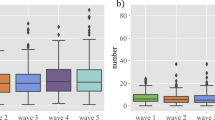Abstract
This study attempts to determine if a relationship exists between first-to-second-year retention and social network variables for a cohort of first-year students at a small liberal arts college. The social network is reconstructed using not survey data as is most common, but rather using archival data from a student information system. Each student is given a retention score and an attrition score based on the behavior of their immediate relationships in the network. Those scores are then entered into a logistic regression that includes tradition background and performance variables that are traditionally significantly related to retention. Students’ friends’ retention and attrition behaviors are found to have a greater impact on retention that any background or performance variable.
Similar content being viewed by others
References
Carrington, P. J., Scott, J., Wasserman, S. (eds.) (2005) Models and methods in social network analysis. Cambridge University Press, Cambridge
Cartwright D., Harary F. (1956) Structural balance: A generalization of Heider’s theory. Psychological Review 63(5): 277–293
Cho H., Gay G., Davidson B., Ingraffea A. (2007) Social networks, communication styles, and learning performance in a CSCL community. Computers and Education 49(2): 309–329
Christakis N. A., Fowler J. H. (2008) The spread of obesity in a large social network over 32 years. The New England Journal of Medicine 357(4): 370–379
Dawson S. (2008) A student of the relationship between student social networks and sense of community. Educational Technology & Society 11(3): 224–238
Dawson S. (2010) “Seeing” the learning community: An exploration of the development of a resource for monitoring online student networking. British Journal of Educational Technology 41(5): 736–752
de Nooy W., Mrvar A., Batagelj V. (2005) Exploratory social network analysis with Pajek. Cambridge University Press, Cambridge
Durkheim E. (1951) Suicide: A study in sociology. The Free Press, New York
Eggens L., van der Werf M. P. C., Bosker R. J. (2008) The influence of personal networks and social support on study attainment of students in university education. Higher Education 55(5): 553–573
Everett M. G., Borgatti S. P. (2005) Extending centrality. In: Carrington P. J., Scott J., Wasserman S. (eds.) Models and methods in social network analysis. Cambridge University Press, Cambridge, pp 57–76
Fruchterman T. M. J., Reingold E. M. (1991) Graph drawing by force directed placement. Software-Practice and Experience 21: 1129–1164
Hanson G.R., Taylor R.G. (1970) Interaction of ability and personality: Another look at the drop-out problem in an institute of technology. Journal of Counseling Psychology 17: 540–545
Heider F. (1946) Attitudes and cognitive organization. Journal of Psychology 21: 107–112
Marsden P. V. (2005) Recent developments in network measurement. In: Carrington P. J., Scott J., Wasserman S. (eds.) Models and methods in social network analysis. Cambridge University Press, Cambridge, pp 8–30
Reffay C., Chanier T. (2003) How social network analysis can help to measure cohesion in collaborative distance-learning. In: Wasson B. B., Ludvigsen S., Hoppe U. (eds.) Designing for change in networked learning environments: Proceedings of the international conference on computer support for collaborative learning 2003. Kluwer, Dordrect, pp 493–502
Rizzuto T. E., LeDoux J., Hatala J. P. (2009) It’s not just what you know, it’s who you know: Testing a model of the relative importance of social networks to academic performance. Social Psychology of Education 12(2): 175–189
Thomas S. L. (2000) Ties that bind: A social network approach to understanding student integration and persistence. The Journal of Higher Education 71(5): 591–615
Tinto V. (1975) Dropout from higher education: A theoretical synthesis of recent research. Review of Educational Research 5(1): 9–125
Author information
Authors and Affiliations
Corresponding author
Rights and permissions
About this article
Cite this article
Eckles, J.E., Stradley, E.G. A social network analysis of student retention using archival data. Soc Psychol Educ 15, 165–180 (2012). https://doi.org/10.1007/s11218-011-9173-z
Received:
Accepted:
Published:
Issue Date:
DOI: https://doi.org/10.1007/s11218-011-9173-z




